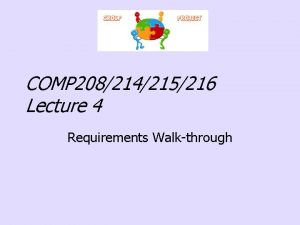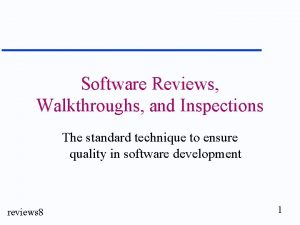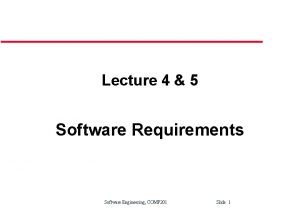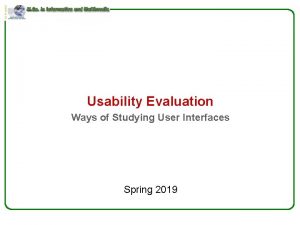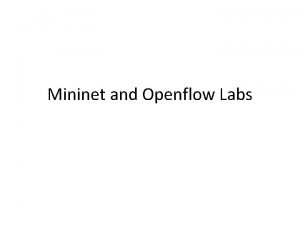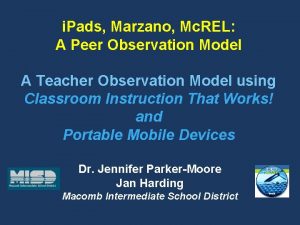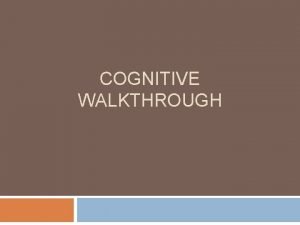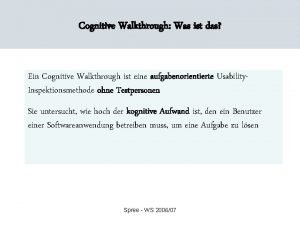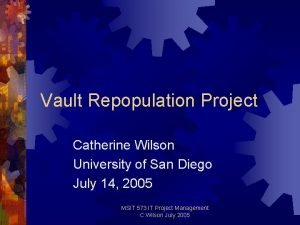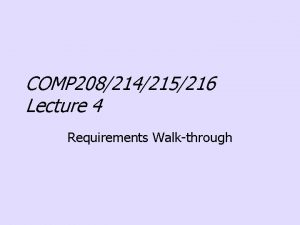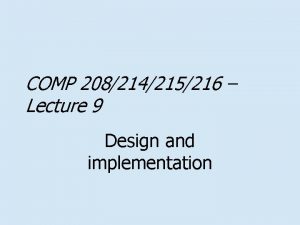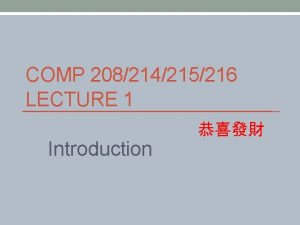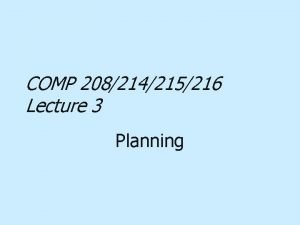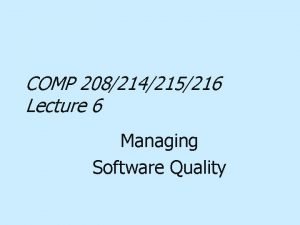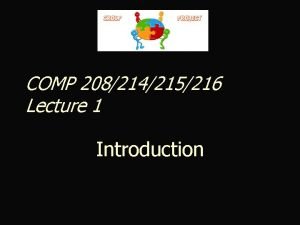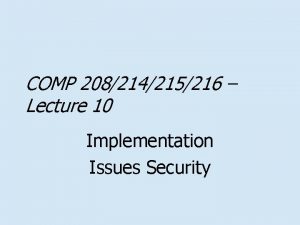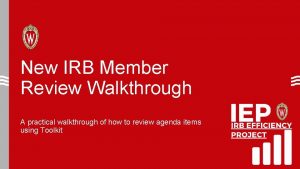COMP 208214215216 Lecture 4 Requirements Walkthrough Requirements Review















- Slides: 15

COMP 208/214/215/216 Lecture 4 Requirements Walk-through

Requirements Review Meeting • This meeting reviews the outputs of the first three steps of the method in Connolly and Begg. • It will review the 7 items of documentation which should be produced in this phase of the project • This review counts as 15% of your group mark.

Organisational Details • The Requirement Specification Walkthroughs will take place in week 4 (between 18 -22 February 2013) • Teams are responsible for arranging a time for the review with their reviewer by Friday 15 February. • The documentation to be reviewed must be submitted on VITAl on or before 12 noon Friday 15 February. • Reviews will typically last 20 -30 minutes.

Documentation Required • • Mission statement Mission objectives System Boundary Diagram User Views and Their Requirements Transaction Requirements (if appropriate) Systems Specification Project Gantt Chart. Descriptions and examples of items 1 -6 are in Connolly and Begg Chapters 3 and 4 (1 st edition) or Chapter 6 (2 nd edition).

Format of the Review • For each deliverable: – A team member introduces the item – The reviewer may ask questions for clarification • Team replies to questions – The reviewer may make comments • Team may briefly respond to comments • A Report Form will be completed by the reviewer and given to the team as soon as possible.

Mission Statement • The mission statement is a single sentence which defines the overall purpose of the database: what it is for • It should be clear and unambiguous • It is not a list of functions that the database will perform: it is the reasons why those functions are wanted. Stay. Home example: p 64 of Connolly and Begg (p 129 in 2 nd edition).

Mission Objectives • The Mission Objectives statement is a list of particular tasks that the system will support • Each objective begins with an infinitive – To maintain/ perform/ track/ find/ report/ show/ record etc. – Indicates which data items to be used • Tasks supported - not who will do them • Should be as comprehensive as possible. Example: Figure 4. 8 of Connolly and Begg (Figure 6. 8 in 2 nd edition).

Systems Boundary Diagram • The intention of this diagram is to represent the main types of data relevant to the system • The boundary shows what will be included in the system and what will be not. Data may be: – In the system – Available on other systems to which links will be provided – Not to be available at all. Figure 4. 9 of Connolly and Begg provides an example (Figure 6. 9 in 2 nd edition).

System Boundary diagram for COMP 215 -216 Administrator System Boundary Mobile User WAP User Interface Database

User Views and Requirements • Purpose: to identify the major classes of user and the functions they will use. – e. g. administrator, teacher, pupil: • Administrator maintains the database: views, adds, modifies, deletes records • Teacher customises the database: views and adds records, but doesn’t modify or delete records • Pupil uses the database: only views records. • In other applications, different users may maintain and use different data items.

More on User Views • We are producing a list of users and, for each user, the functions they need: • Functions should relate to mission objectives: – Every user function should be included in mission objectives – Every mission objective should relate to some user function – Several users may use the same function. Example at figure 4. 10 of Connolly and Begg (Figure 6. 10 in 2 nd edition).

Transaction Requirements • Each user view will involve certain transactions, stipulating how the data is to be used • There are three broad categories: – Data entry: every data item needs to be created somewhere – Data update and deletion – Data queries. • Transactions should be related to the user view to ensure all functions are supported.

System Requirements • Various aspects to cover here: – Initial Database Size – Rate of Growth – Expected type and frequency of searches – Network and Access requirements – Performance – Security – Back-up and Recovery – Legal Issues • Detail required will vary according to application and environment – e. g. a stand alone single user application will need less detail on access and requirements than a commercial multi-user system.

Project Gantt Chart • A chart showing the major milestones, tasks and deliverables of the project and when they are scheduled • You need to report your past progress and future plans. • You will need to update this chart for each Walkthrough.

Summary By FRIDAY 15 FEBRUARY 2013 • You must book your meeting. • You must supply the requirement documents During the week 18/02 – 22/02 • You must attend the review meeting • Please attend the meeting punctually • This review is an important milestone: it lays the foundations for the project.
 Requirements walkthrough
Requirements walkthrough Peer review walkthrough and inspection in software testing
Peer review walkthrough and inspection in software testing 01:640:244 lecture notes - lecture 15: plat, idah, farad
01:640:244 lecture notes - lecture 15: plat, idah, farad What is domain requirements in software engineering
What is domain requirements in software engineering Objectives of work immersion
Objectives of work immersion Cognitive walkthrough vs heuristic evaluation
Cognitive walkthrough vs heuristic evaluation How to install mininet in virtualbox
How to install mininet in virtualbox Mcrel walkthrough
Mcrel walkthrough Cognitive walkthrough vs heuristic evaluation
Cognitive walkthrough vs heuristic evaluation Uiecu
Uiecu Cognitive walkthrough example
Cognitive walkthrough example Cognitive walkthrough and heuristic evaluation
Cognitive walkthrough and heuristic evaluation Medieval times walkthrough
Medieval times walkthrough Cognitive walkthrough
Cognitive walkthrough Adventure high walkthrough
Adventure high walkthrough Vaultrepopulation
Vaultrepopulation
